Drones - Group 4 - 2018/2019, Semester B, Quartile 3
- Page navigation
- Root
- Notes from meeting
- Initial ideas
- Project setup
- General problem description
- State of the Art
- Specific problem description
- Present situation
- Drone analysis
- Solution analysis
- Airport analysis
- Decision Model investigation
- Decision Model implementation
- Decision Model validation
- Categorising solutions
- Web Application
- Future
- Conclusion
- Discussion
Drones
Introduction
There exist various categories of drones. For example, not only small drones for recreational use exist but also large weaponised drones. It is important to categorise the various types of drones that exist in order to deal with each category appropriately. Furthermore, the current rules and regulations when it comes to commercial and recreational use of drones are essential to consider as well. We do this in order to get a better understanding of what is allowed and what is not allowed. This better understanding will make it easier to provide solutions for the various categories of drones and their usage.
Current regulation
When considering the current rules and regulations, we do not merely restrict ourselves to the rules and regulations surrounding airports, but we increase the width of our view to a more general perspective as we think we might do interesting findings this way. Different countries have different rules and regulations when it comes to UAVs. Furthermore, distinctions are made between recreational use and commercial use. The United States of America (U.S.A.), for example, considers different rules when it comes to recreational use and commercial use. The requirements when flying a drone under commercial use are much stricter than flying a drone under recreational use. If one wants to fly under commercial use, one has to pass an FAA test and receive Part 107[1] certification. Furthermore, a drone needs to be registered so that the owner of the drone can be traced back in case this is needed.
A few guidelines to follow when flying a drone in the U.S.A are as follows[2]:
- Fly at or below 400 feet
- Keep your drone within sight
- Never fly near other aircraft, especially near airports
- Never fly over groups of people
- Never fly over stadiums or sports events
- Never fly near emergency response efforts such as fires
- Never fly under the influence
- Be aware of airspace requirements
There exist applications, available for smartphones and on the web, that display where a drone is allowed to fly. One example is AirMap that shows users that they should be at least five miles away from an airport to operate the drone without notifying the control tower of the airport. As you might have realised by now, the rules and regulations regarding drones are still a work in progress. As the rules and regulations per country differ significantly, we will solely focus on the rules and regulations considered in the Netherlands. This is only natural as the project is carried out in the Netherlands as well.
The Netherlands considers different rules and regulations based on the type of usage of the drone. The main categories specified by the Dutch Government consider recreational use and commercial use.
Recreational use
When one flies a drone for personal purposes, one must abide by the Model Aeroplanes Regulations[3]. This means that one is not permitted to fly over groups of people or connected buildings. Furthermore, the drone needs to be in sight at all times. As soon as one sees an aeroplane or helicopter approaching, one must land as quickly as possible.
For reasons of safety, it is not allowed to fly a drone just anywhere. As mentioned earlier, it is not allowed to fly over groups of people.
The Dutch Government has also set down requirements regarding the conditions under which it is allowed to fly[4].
This includes but is not limited to:
- You must be able to see the drone at all times.
- You may not fly in the dark.
- You must always give priority to all other aircraft, such as aeroplanes, helicopters, gliders, et cetera. This means that you must land immediately once you see an aircraft approaching.
An overview map for the recreational use of drones has been depicted in Figure 1.
This image accurately presents where one is allowed to fly their drone for recreational use and where it is forbidden to fly a drone.
An interesting observation that can be done from this image is that in many significantly sized cities, it is forbidden to fly a drone at all.
Furthermore, for uncontrolled airports, flights within a distance of 3 kilometres are permitted, provided that there is no objection from the airport operator.
Additionally, there may always be temporary bans and restricted areas for a limited time due to, for example, events.
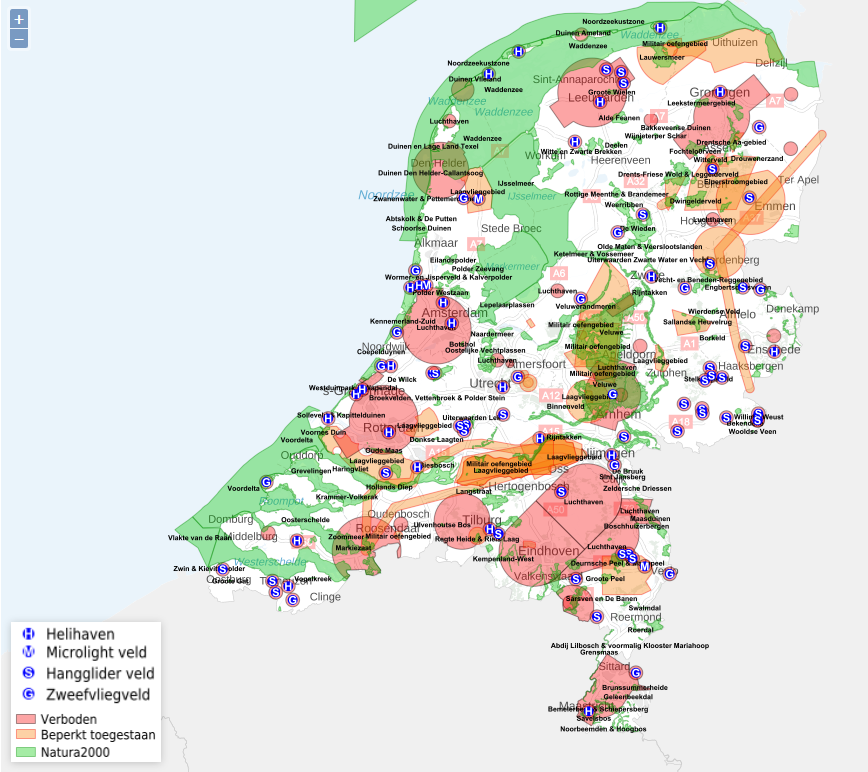
There also exists a maximum weight for private drones of 25 kilograms. Making films and photographs with a drone may only be done for personal use.
Here, the privacy right of others must be kept in mind. It is, for example, not allowed to film someone secretly.
If pictures are being taken of a specific person or that person is being recorded, the person concerned must be informed.
This leads us to the following point. The owner of a drone is responsible for any damage caused by their drone.
This means that the owner of a drone is liable for any damages or injuries caused by their drone.
Therefore, it is vital for the owner of a drone to verify whether their liability insurance covers any damage to drone incidents.
In some cases, it is possible for the damage to run up to a substantial sum up to thousands of euros.
We can further extend this by considering fines that can be given to drone pilots.
Failing to abide by the rules mentioned above can result in either a warning or a fine.
It is also possible for the controlled drone to be confiscated.
The amount of the fine or the punishment is given depends a lot on the type of violation caused by drone usage.
It will be considered if the drone was used in a professional setting or for hobby purposes.
Furthermore, it will be considered if people were endangered or not.
The Dutch Government provides a summary in a visual form of what guidelines to follow during recreational usage of drones[5]. This visual can be observed in Figure 2. This figure accurately presents the most important rules to follow when using drones in a recreational setting. Note that the text on this figure is in Dutch.
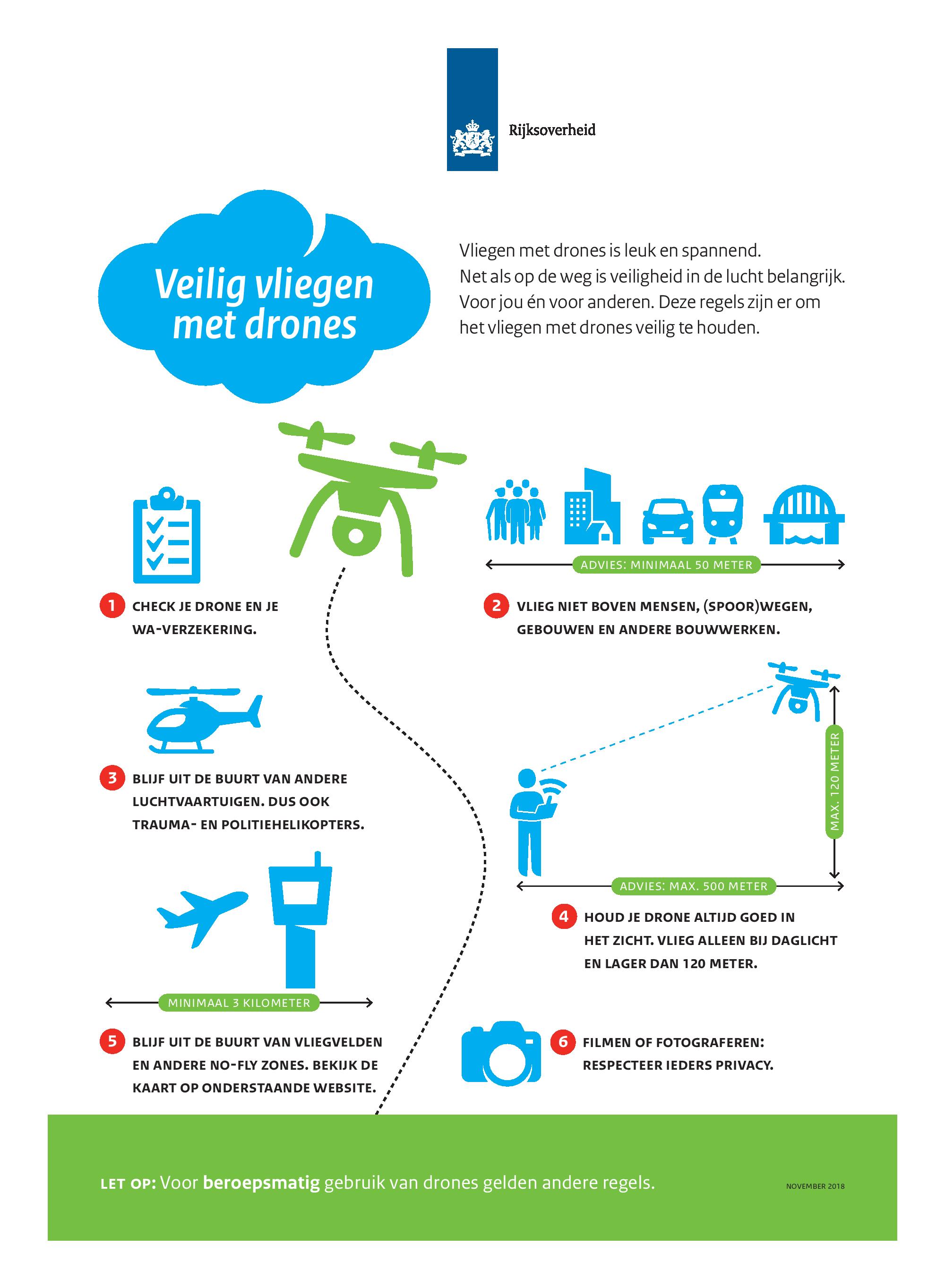
Commercial use
On the other hand, we can also consider the commercial use of drones. Examples include but are not limited to people that use the drone to earn money or people that use drones for business purposes. For these commercial users, different rules and regulations apply than for recreational users. A commercial user needs, for example, a license. The additional rules and regulations for commercial users must minimise the risk of accidents, both in the air and on the ground.
Examples of commercial uses include:
- Video production companies that make aerial shots.
- Making promotional films for a company.
- Using a drone for a business, such as companies that want to view hard-to-reach places for specific reasons.
For using a drone in a commercial setting, the owner of this drone needs an RPAS Operator Certificate (ROC).
One can be requested from the `Inspectie Leefomgeving en Transport' (ILT).
If someone is piloting the drone, then this person also needs a pilot's license (vliegbrevet in Dutch).
Furthermore, a certificate of airworthiness and proof of enrollment in the aviation register is needed[6].
There exist two sorts of ROC licenses, namely a regular ROC and a ROC Light.
If a drone is heavier than 4 kilograms, then a ROC is needed.
Otherwise, a ROC-light will be fine in most cases.
Additionally, it is not allowed to fly as high with a ROC Light compared to a regular ROC.
Other differences are displayed in Table 2 below. Here, one can more clearly observe the differences between a ROC and ROC Light.
We will not display all difference here as we save this for the next section where we also compare the commercial use to the recreational use.
| Rules license | Drone heavier than 4 kilograms | Drone lighter than 4 kilograms |
|---|---|---|
| Type of license | ROC | ROC-light |
| Maximal weight of drone allowed | 150 kg | 40 kg |
| Maximal flight height | 120 metres | 50 metres |
| Maximal distance between drone and owner | 500 metres | 100 metres |
| Minimal distance towards crowds | 150 metres | 50 metres |
| Minimal distance to buildings | 150 metres | 50 metres |
| Minimal distance to highways | 150 metres | 150 metres |
If one does not abide by the rules, it is possible to obtain a fine and for the drone to be confiscated.
People who do wrong more often can also get a prison sentence.
The National Coordinator for Counterterrorism and Security (NCTV) focuses on the abuse of drones.
The NCTV cooperates with national and international government organisations.
Given fines can be around +/- 400 euros for commercial usage with a ROC Light and +/- 10 000 euros for commercial usage with a ROC.
Summary
In this section, we provide a summary when considering recreational, commercial (ROC), and commercial (ROC Light) usage of drones. These rules and guidelines are from the most up-to-date version provided by the Dutch Government[7] (20-09-2016).
| Reacreational flying | Commercial flying (ROC) | Commercial flying (ROC Light) | |
|---|---|---|---|
| Use of a drone | Hobbyism, recreational use | Commercial use | Commercial use |
| Weight drone (total starting mass) | Max. 25 kg | Max. 150 kg | Max. 4 kg |
| Priority for other air traffic | Gives priority to all other air traffic and lands immediately when other traffic is approaching. | Gives priority to all other air traffic and lands immediately when other traffic is approaching. | Gives priority to all other air traffic and lands immediately when other traffic is approaching. |
| Visual Flight Rules | Always in sight of the pilot | Always in sight of the pilot | Always in sight of the pilot |
| Distance to pilot or observer | N/A | Max. 500 metres | Max. 100 metres |
| Daylight | Only daylight | Only daylight | Only daylight |
| Height (from ground/water) | Max. 120 metres. Some exceptions (KNVvL or FLRVC members): max. 300 metres | Max. 120 meters (exemption possible in ROC) | Max. 50 metres |
| Distance criteria: | Exemption possible | Exemption impossible | |
| Distance to crowds | Not above | Min. 150 metres | Min. 50 metres |
| Distance to buildings | Not above | Min. 150 metres | Min. 50 metres |
| Distance to works of art, port, and industrial areas | Not above | Min. 50 metres | Min. 50 metres |
| Distance to railway lines | Not above | Min. 50 metres | Min. 50 metres |
| Distance to public roads and motorways | Not above except for roads in 30 km zones within the built-up area and roads in 60 km areas outside the built-up area | Min. 50 metres | Min. 50 metres |
| Distance to vessels and vehicles | N/A | Min. 150 metres | Min. 50 metres |
| Where are you allowed to fly? | Not in controlled airspace | Not in controlled airspace | Not in controlled airspace |
| Not within 3 km of uncontrolled airports, unless there is no objection from the operator | N/A | Not within 3 km of uncontrolled airports, unless there is no objection from the operator | |
| Not in the military and civilian low-flying areas, unless with an observer | N/A | Not in the military and civilian low-flying areas, unless with an observer | |
| Proof of Authority for the pilot / driver ('brevet') | N/A | Certificate of Competence (RPA-L)(medical examination compulsory, at least LAP-L) | Exemption Certificate of Competence Well: pilot can demonstrate sufficient competence, e.g., with a KEI diploma or a recognized pilot's license(this requirement does not apply if the drone weighs less than 1 kg) no medical examination |
| Certificate of Airworthiness for the drone | N/A | Certificate of Airworthiness (technical inspection required) | Exemption Certificate of Airworthiness (no technical inspection) |
| Registration in aircraft register | N/A | Proof of registration | Proof of registration |
| Minimum age | N/A | 18 years old | 18 years old |
| Operational manual | N/A | Handbook necessary | N/A |
| Insurance | Not required | WA insurance required | WA insurance required |
| Notification obligation | N/A | 24 hours before the flight with Minister and mayor NOTAM | N/A |
| Fines | N/A | +/- 10 000 euro | +/- 400 euro |
Future regulation
Before reading the next text, keep in mind that most of the things elaborated on below hold as of now, but that they can change in the future when the final rules and regulations regarding drones are published. The introduction of mandatory knowledge requirements for recreational drone users will no longer take place at a national level. The primary regulation for EASA came into effect on the 11th of September, 2018[8]. This means that the responsibility for civilian drone regulations is transferred from the Netherlands to the European Union once the European regulations regarding drones come into effect. The Netherlands is, however, still responsible for the national implementation and execution of these regulations. It is expected that this regulation will be published in the June 2019[9] and will take effect early 2020[10]. Furthermore, there will most likely be a transition phase of roughly two years where national documents (licenses, et cetera) can still be used. The European drone regulations will replace the national regulations regarding airworthiness of drones, pilots of drones, and flight operations concerning drones. The moment these new regulations are active, the air traffic regulations for civilian drones laid down in the `Regeling Modelvliegen' and `Regeling op afstand bestuurde luchtvaartuigen' will be withdrawn.
The European rules are based on the risk that flying with a drone entails.
There will be no more distinction between professional and recreational flying.
The regulations will focus on different categories based on the risk involved for third parties both in the air and on the grond[8].
These categories consist of:
- the open category for low risk,
- the specific category for higher risk, and
- the certified category for the riskiest operations.
The operational conditions under which the flight is carried out, such as the flight altitude, determine the category in which a flight falls.
Note that there is a summary section below that summarises the different types of operations together with the different types of drones in a very concise and understandable way. One should go to these if one does not want to go into all the details regarding the types of operations and the types of drones.
The EASA
While the preceding description provides a rundown of what to expect, it is possible to consider subcategories within the open category. It was decided by the European Aviation Safety Agency (EASA) to further partition operations in the open category into three subcategories to allow different types of operations without the need for authorisation[11]. This subdivision was made in Opinion No 01/2018 made by the EASA. The objective of this Opinion, as described in Opinion No 01/2018[11], is to create a new supervisory framework that defines means to alleviate the risk of operations in the:
- open category; through a mixture of limitations, operational rules, and requirements for the competency of the operator, as well as technical requirements for UAVs, such that the UAV operator may conduct the operation without prior authorisation by the competent authority, or without submitting a declaration, and
- specific category; through a system that includes a risk assessment being conducted by the UAVs operator before starting an operation, or an operator complying with a standard scenario, or an operator holding a certificate with privileges.
Additionally, the Opinion provided by the EASA intends to:
- implement an operation-centric, proportionate, risk- and performance-based regulatory structure for all UAV operations conducted in the open and specific categories,
- ensure a vast and uniform level of safety for UAV operations,
- foster the development of the UAV market, and
- contribute to addressing citizens’ concerns concerning security, privacy, data protection, and environmental protection.
The proposed Opinion will harmonise operations regulations in Europe and create a general EU market for drones. It will allow everyone to buy and operate a drone ensuring the following attributes:
- safety; by keeping drones away from crewed aircraft, protecting people and critical and sensitive infrastructure,
- security; by keeping drones at an appropriate distance from nuclear reactors; military bases or oil pipelines,
- privacy; using a proper separation from residential areas;
- environmental protection, by reducing the noise level.
Consumer information
One of the novelties EASA has is the combination of product and aviation legislation in these new rules. In particular, design requirements for small drones (up to 25kg) will be implemented by using the well-known Conformité Européenne (CE) marking for products brought on the market in Europe. All European drones are assigned a CE-Marking. This marking consists of a number between 0 and 4, which specifies the class of the drone. We can then consider the following classes: C0, C1, C2, C3, and C4. Operators of drones will then find in each drone package a digital consumer information with the “do’s and don’ts” related to each class on how to fly a drone safely. These “do’s and don’ts” can be seen here. We provide an excellent overview of these classes together with the subcategories of the drones in the open category below.
The open category
One of the conditions for the open category concerns a maximum altitude of 120 meters. For all drones more massive than 250 grams, requirements concerning the knowledge of the pilot are imposed on the pilot. Furthermore, product requirements apply to drones this category, such that it is reliable enough and has the right functionality, such as geofencing, on board. The open category probably includes recreational or professionally controlled drones with a mass of heaver than 250 grams and lighter than 4 kg. The operators of these drones will probably need a 'theory certificate'[10]. This certificate is comparable with the current Dutch theory certificate needed for mini-drones. It is expected that the (unqualified) Dutch mini-drone theory certificate can be converted into a European document or considered as valid without conversion. This also applies to those who fly a microdrone (max. 1 kg) and have an exemption for this (a ROC light permit). These operators still have more than two years to achieve that theory certificate. This certificate is only necessary if one wants to fly outside a model airfield.
In the Opinion mentioned above, which has been designed by the EASA, it was decided to subdivide operations in the open category into three subcategories further to allow different types of operations without the need for authorisation. The subcategories were defined according to the risks posed to persons and objects on the ground. Furthermore, these operations are all below 120m in height and far from aerodromes. The subcategories of the open category are:
- A1: flights over people but not over open-air assemblies of persons;
- A2: flights close to people, while keeping a safe distance from them;
- A3: flights far from people.
An overview of the requirements put on these subcategories together with the CE markings can be seen below in Figure 2.
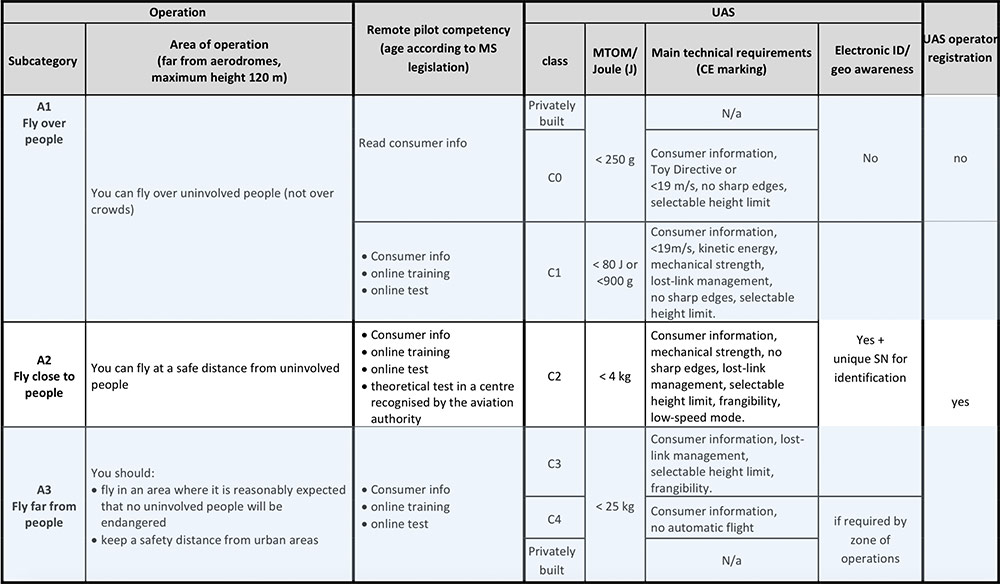
The specific category
The specific category has no restrictions in advance such as a maximum height or not being allowed to fly over people. In the specific category, professionally controlled drones are considered that have a risk that is greater than that in the open category. This can, for example, be the flights for which a ROC is now required, which is the case when a drone is heavier than 4 kg[10]. If the operation carried out does not meet the requirements that apply to the open category, it will, in most cases, fall into the specific category. This holds unless there is a risky operation requiring a certificate (see below). For an operation in the specific category, the operator has to carry out risk analysis. Based on the results of this risk analysis, the operator must propose mitigating measures to keep the risk of the operation low enough. This analysis is then handed over to `Inspectie Leefomgeving en transport' (ILT) which, after testing the analysis, can grant a license to the operator. Because there are no restrictions in the regulations in advance, this category offers considerably more opportunities for operators than the current national regulations. Flying above buildings, in the dark, out of sight of the pilot and even flying with an autonomous drone belongs in this category to the possibilities.
The certified category
In the current proposals for European legislation (1 Nov. 2018), an operation falls into the certified category if the UAV is more significant than 3 meters and is flown over a crowd, when people are being transported by the UAV, and if hazardous substances are transported that can create dangerous situation in the event of a collision. We provide a concrete list below. Besides, if the risk analysis in the specific category shows that the risk of the operation is too high for the operation to be classified as the specific category, it is classified as the certified category.
Drones fall within the certified category if the risk of the intended flight is probably only to be controlled by setting strict requirements (through certification) on both the operator and the drone. This is the case, for example, with:
- flights with drone
- with which people are transported, or
- dangerous goods are transported where a high risk may arise for third parties in the event of a crash, or
- flights with large or complex drones:
- almost constantly above crowds,
- outside view distance, or
- in a part of the airspace where much other air traffic is present.
What does this mean for us?
Drs. C. van Nieuwenhuizen Wijbenga, `Minister van Infrastructuur en Waterstaat', stated that she is currently working on a plan for the national implementation of the European drones rules[9]. She further elaborates that she can finalise this plan and make it public once the rules are fixed at EU level. At that time, she will also organise a large information meeting to inform all national stakeholders in the drones dossier on the European rules and the national implementation plan. Her current estimate is that this meeting can take place in the first quarter of 2019. One of the components of this plan she proposes is the implementation at a national level of zones in which drones are not allowed to fly or are restricted. Before the establishment of these zones, the various stakeholders such as municipalities and the drones sector will discuss the criteria for zoning. The plan itself takes into account the transitional periods that will be included in the European regulations.
Summary
In case one does not want to read all of the above text, we provide a concise summary here that considers all of the major elements that should be kept in mind when it comes to different types of operations and drones in the close future.
When it comes to drones use, we will (most likely) consider the following categories of operations:
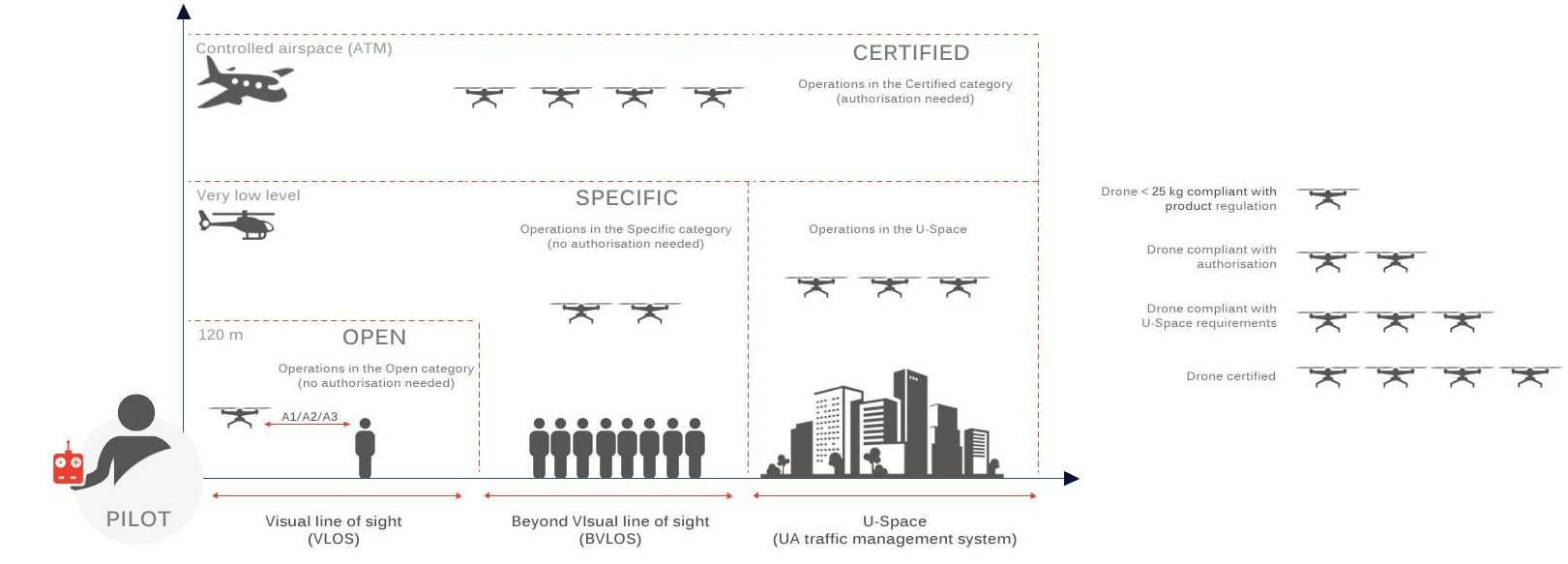
In-depth, these categories are as follows:
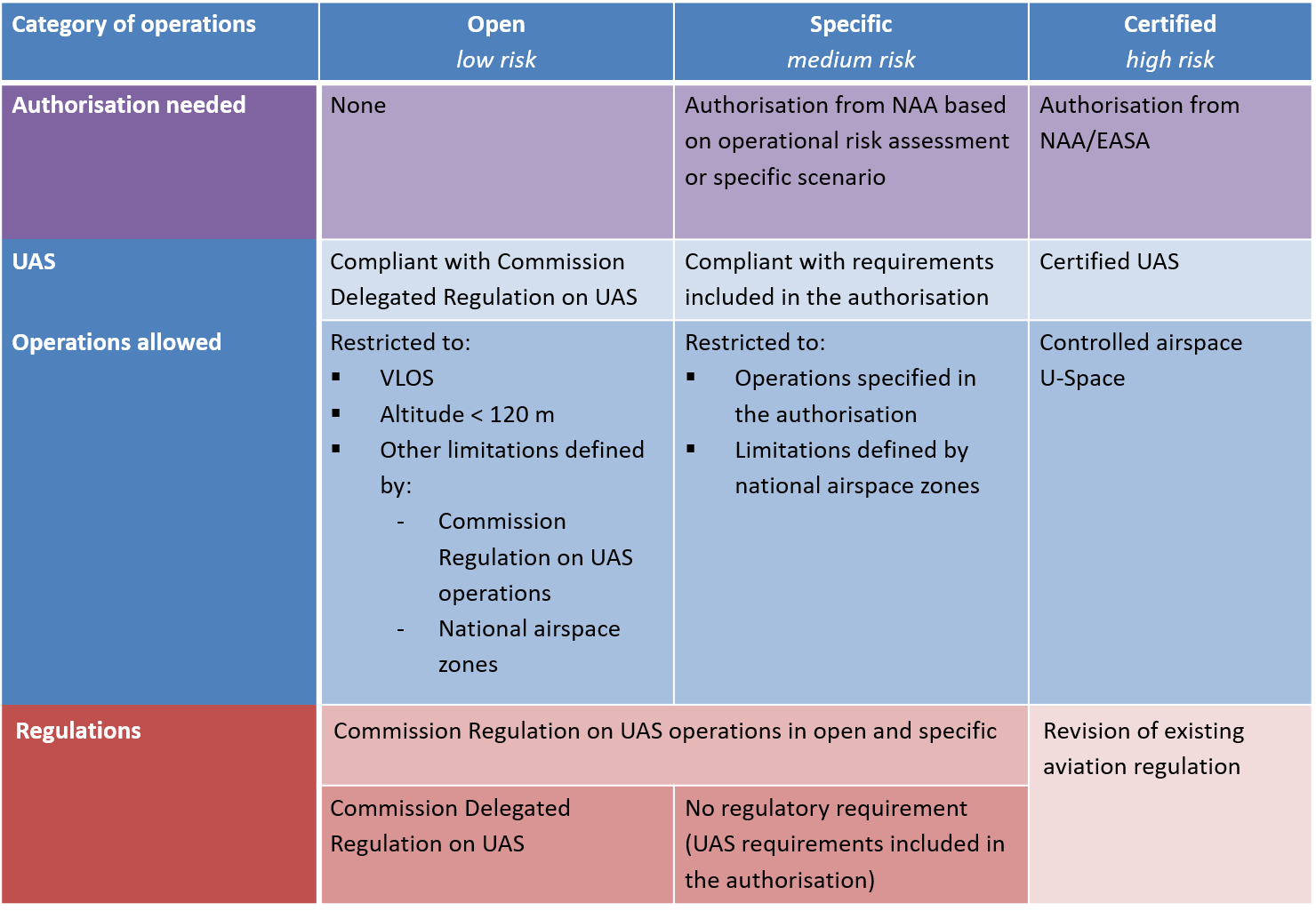
When it comes to the open category, the various subcategories within the open category, and the various C markings, we consider the following:
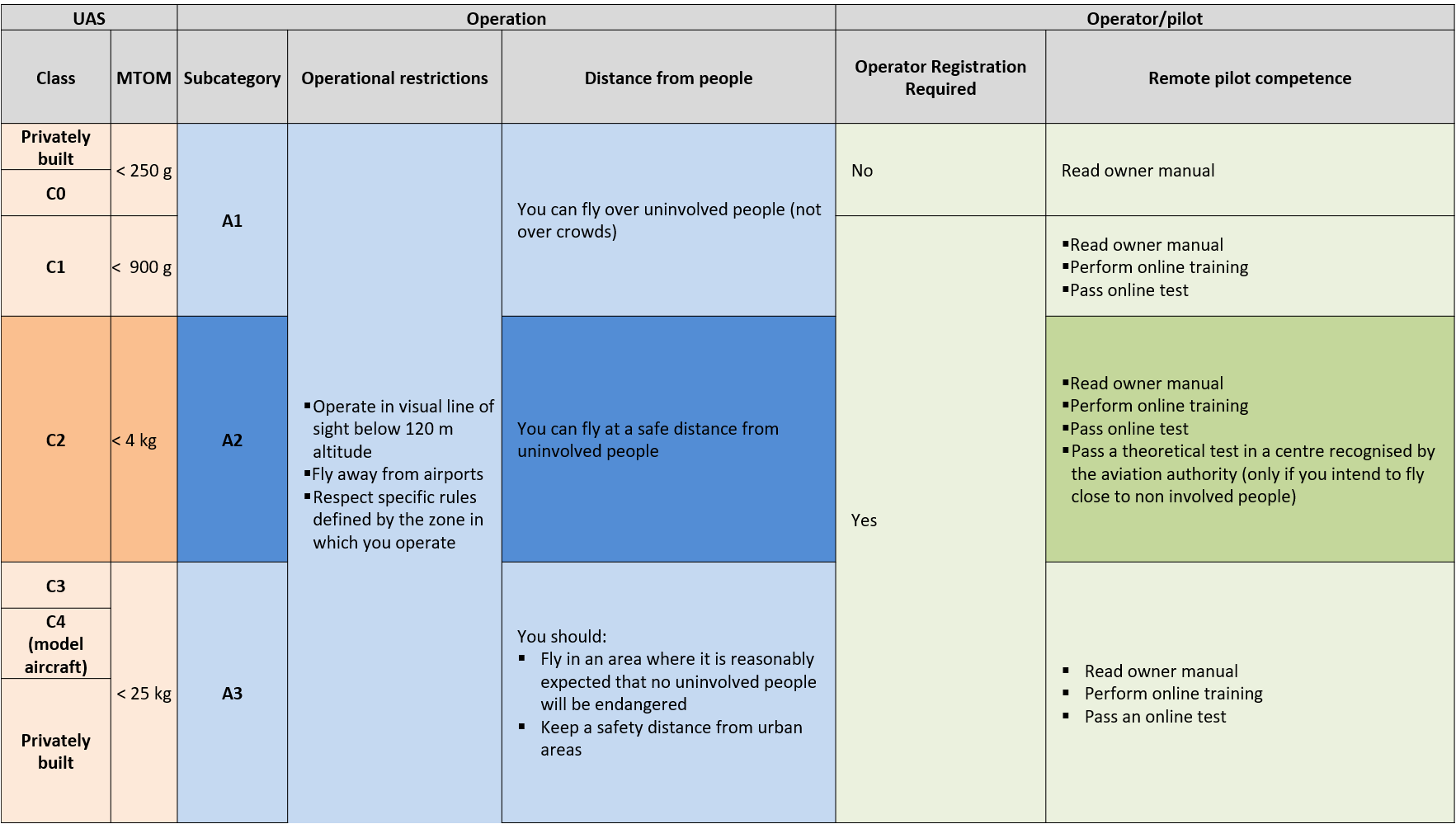
Figure 5 accurately depicts what a typical customer that is wanting to buy a commercial drone is interested in.
Dangers
Let us consider a few of the dangers that various types of drones can impose on airports. We limit ourselves to two broad types of dangers that drones can introduce near airports. When we consider different types of airports on the Airports page, we take a deeper dive into the most considerable dangers that are introduced for each specific type of airport.
Collisions with aeroplanes
It is possible for drones to collide with aeroplanes. Of course, smaller drones are more likely to inflict less damage upon the aeroplane than larger drones. In this section, we consider the possible types of damages drones, in general, can inflict upon aeroplanes as going in-depth about which drones can inflict what kind of damage falls outside of the scope of this project. Figure 3 provides a visualisation of the types of damage that can be inflicted upon aeroplanes by all sorts of drones.

If a collision between a drone and an aeroplane takes place, the damage inflicted upon the aeroplane can differ.
There is a high probability that the drone in question will be destroyed.
Then, it is possible for this drone to become unable to operate, which in turn, can result in that drone falling.
Then, it is possible that someone or something gets hit by this drone, which could lead to the death of people and the destruction of things hit.
Furthermore, a collision between an aeroplane and a drone can cause no damage at all, superficial damage, or severe damage to the aeroplane in question.
Below, one can observe a demonstration of a drone striking the nose cone of an airliner from the Crashworthiness for Aerospace Structure and Hybrids (CRASH) Lab at Virginia Tech.
Note that the aeroplane is standing still in this scenario and that real collisions are bound to take place at higher speeds, which often results in more power being involved in the equation.

Let us ignore when no damage or superficial damage is inflicted as these types of damage do not put the aeroplane at significant risk.
If, however, severe damage is inflicted upon the aeroplane, it is possible that component failures take place or that persons on board are injured.
Component failure and injuries of people on board can lead to an unsafe landing.
Additionally, if the pilots of the aeroplane get injured, it is possible for loss of control and an eventual crash of the aeroplane.
Note that this is the worst case scenario, but that it is vital to consider these worst cases.
In turn, an unsafe landing or loss of control can lead to more injuries of persons on board due to people walking over one another trying to escape the aeroplane or due to the crash.
All in all, we observe that drones can cause disastrous consequences when it comes to collisions with aeroplanes.
Armed drones
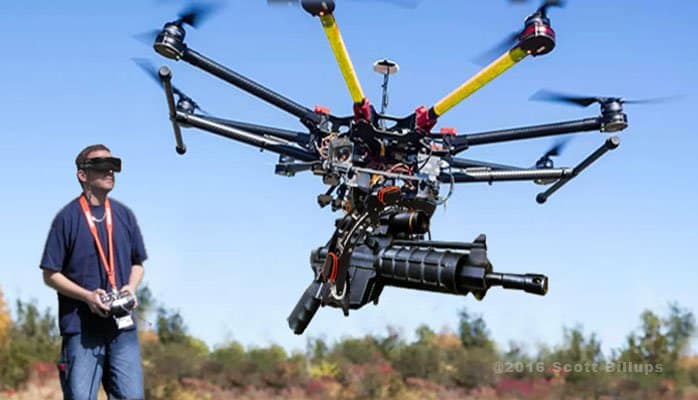
It is possible that armed drones are used for planned attacks on airports. While this is a worst-case scenario to happen, it should still be considered, and measures should be taken against this scenario. These type of drones could be equipped with long-range weapons such that airport detection systems cannot detect them or with explosives. In the case that drones are equipped with explosives, it is possible for the drone to `simply' infiltrate the airport and explode, which can put the lives of many people at risk. On the other hand, when long-range weapons are used, it is possible that the airport detection systems do not detect these drones. Then, these drones could freely attack the aeroplanes and also the airport. This, also, puts the lives of many people at risk. One example of a weaponised drone can be seen on the right-hand side.
Back to the root page.
References
- ↑ U.S.A. Government https://www.faa.gov/news/fact_sheets/news_story.cfm?newsId=20516
- ↑ Jim Fisher, Drone Regulations: What You Need to Know, Aug. 23 (2018) https://www.pcmag.com/article2/0,2817,2491507,00.asp
- ↑ Regeling modelvliegen https://wetten.overheid.nl/BWBR0019147/2015-11-07
- ↑ Dutch Government, Rules for recreational use of drones https://www.government.nl/topics/drone/rules-pertaining-to-recreational-use-of-drones
- ↑ Veilig vliegen met drones https://www.rijksoverheid.nl/binaries/content/gallery/rijksoverheid/content-afbeeldingen/onderwerpen/drone/drone-2018.jpg
- ↑ Welke vergunning heb ik nodig voor mijn drone? https://www.rijksoverheid.nl/onderwerpen/drone/vraag-en-antwoord/vergunning-drone
- ↑ Regels voor drones: verschillen tussen recreatief en beroepsmatig gebruik https://www.rijksoverheid.nl/onderwerpen/drone/documenten/brochures/2016/07/06/regels-voor-drones-verschillen-tussen-recreatief-en-beroepsmatig-gebruik
- ↑ 8.0 8.1 Beantwoording vragen Schriftelijk Overlag drones, 1 November 2018, Ministerie van Infrastructuur en Waterstaat https://www.rijksoverheid.nl/onderwerpen/drone/documenten/kamerstukken/2018/11/01/beantwoording-vragen-schriftelijk-overleg-drones
- ↑ 9.0 9.1 Beantwoording vragen van het lid Remco Dijkstra (VVD) over drones bij Londen-Gatwick , 15 Jan. 2019 https://www.rijksoverheid.nl/onderwerpen/drone/documenten/kamerstukken/2019/01/15/beantwoording-vragen-van-het-lid-remco-dijkstra-vvd-over-drones-bij-londen-gatwick
- ↑ 10.0 10.1 10.2 Nieuwe Europese regels https://www.ilent.nl/onderwerpen/drones/nieuwe-europese-regels
- ↑ 11.0 11.1 Opinion No 01/2018, Introduction of a regulatory framework for the operation of unmanned aircraft systems in the open and specific categories https://www.easa.europa.eu/sites/default/files/dfu/Opinion%20No%2001-2018.pdf